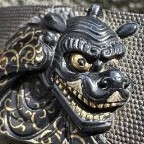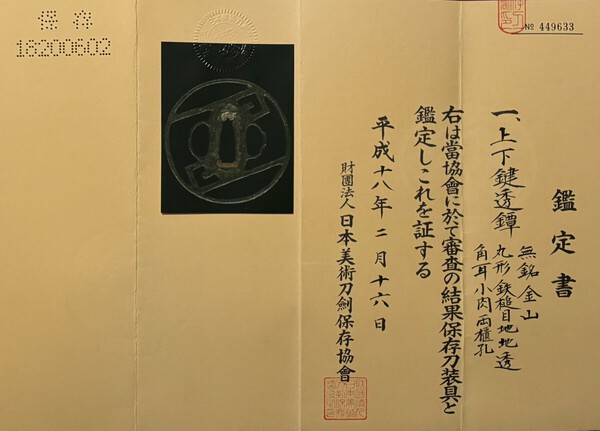-
Posts
460 -
Joined
-
Last visited
-
Days Won
2
Iaido dude last won the day on December 4 2024
Iaido dude had the most liked content!
Contact Methods
-
Website URL
hyotanantiquesandcollectibles.com
Profile Information
-
Gender
Male
-
Location:
Gainesville, Florida
-
Interests
Sukashi tsuba (up to early Edo), iaido, kyudo, Japanese zen paintings (pre-17th century)
Profile Fields
-
Name
Steve H
Recent Profile Visitors
3,465 profile views
Iaido dude's Achievements
-
Lovely, Curran. They represent the 3rd style according to Fred Geyer’s paper on this topic. They speak of religious faith and sacrifice. I’m fascinated by the way in which Christianity resonated with a Buddhist mindset.
-
"Generic Edo Period" with numerous influences including Kyo-sukashi, Owari, Ohno smiths, which was sold as a Tanshu Sadamasa. I just like the very large size, heaviness, and motifs; mounts nicely on my katana for tameshigiri. Unexpectedly, it seems to have tekkotsu, but I dont' think it is Momoyama/early Edo. The indented tail feather motif seen at the bottom is unusual and not seen in earlier periods.
-
-
-
In response to Steve's plea for more steel tsuba: Ex-Sasano (gold book Plate 75) Kanayama "Thunderbolt"
-

Suio Genro Daruma Painting with Inscription
Iaido dude replied to Iaido dude's topic in Other Japanese Arts
-
Suio Genro (遂翁元盧, 1717-1790) became a disciple of Hakuin Ekaku at age 30. After the death of his master, he took over the Shōinji Temple. His calligraphy and painting reflect his master's style and depictions, especially of Daruma. This example, a favorite in my collection, is a decided departure from the depiction of a somewhat comically "clueless" patriarch and has much of the fierceness of Fugai Ekun's depiction especially in the eyes, and the flying white strokes that define the body are more angular and powerful. This is a more commanding and intimidating visage, which appears to have been inspired by both masters. However, his calligraphic style owes much to Hakuin. The inscription is of the classic Zen teaching regarding the non-verbal transmission of the mind/heart from master to disciple, traditionally attributed to Daruma. The third and fourth lines frequently accompany the Daruma paintings of Hakuin and Yamaoka Tesshu. A special transmission outside the scriptures, (kyōge betsuden 教外別傳) not founded upon words and letters, (furyū monji 不立文字) [Zen] points directly to the human heart/mind, (jikishi ninshin 直指人心) see into your nature, become Buddha! (kenshō jōbutsu 見性成佛) What does it mean to have a non-verbal transmission? I have asked Kenneth Kushner Roshi (Chosei Zen Dojo, Madison, WI) about this in relation to koan study. Rather than the common understanding of koans as puzzles or riddles, they are most commonly a record of direct encounters between master and student in a question/answer format, collected and widely distributed for centuries as a way to bring the immediacy of the Zen teaching character of great masters into the practice of future generations. It is the closest we can know of having an actual conversation with important Zen masters and Patriachs of the foundational Ch'an Buddhist lineage. The Rinzai school places a greater emphasis on koan study than the Soto school. Kushner Roshi says that when a student provides the "answer" to an assigned koan in face-to-face meetings, it is not through an intellectual or clever verbal explanation that the teacher recognizes a penetration of the koan. Rather, the enlightenment experience of seeing to the nature of the self (kensho) is expressed through evidence of a transformative and often physical experience that is ineffable, but that this is readily apparent to the teacher. Having not embarked on koan study, it is difficult for me to describe what this experience is like. However, even if I were engaged in such study, it is likely that I would not be able to do much better by way of explanation. This is truly a "special transmission" that is "not founded upon words and letters." Fugai Ekun Yamaoka Tesshu Hakuin Ekaku
- 1 reply
-
- 2
-

-

-

Otagaki Rengetsu Fan ("White Chrysanthemums...")
Iaido dude replied to Iaido dude's topic in Other Japanese Arts
Here is another translation, which I like better. Lines 2 and 3 are shown with the correct kanji as they appear in the inscription. when white chrysanthemums by my pillow perfume the dark dreams of many autumn nights come back to me shira giku no (志らぎくの) makura ni chikaku (枕にちかく) kaoru yo wa (かをるよハ) yume mo iku yo no (夢もいくよの) aki kaenu ran (秋かへぬらん) Translation by Sayumi Takahashi in: Black Robe White Mist--art of the Japnaese Buddhist nun Rengetsu. M. Eastburn, L. Folan, and R. Maxwell; National Gallery of Australia (2007), pg. 69 -
Jan, there was no age given in her signature for our two renditions of her poem. How do you date yours as an early work? The poem itself or the fact that she did the painting herself? I have see numerous examples in which she choses to paint different subjects that appear in her waka, as in this case.
-
Ōtagaki Rengetsu (1791-1875). This calligraphy with painting is one of her most famous waka, evoking a melancholic solitude that was part and parcel of the life she led as a Buddhist nun. The moon or sun peeking out from the clouds is a lovely touch. living deep in the mountains i’ve grown fond of the sighing pines-- on days when the wind is still how lonely it becomes yamazato wa (やまさとハ) matsu no koe nomi (まつのこゑのみ) kiki nare te (ききなれて) kaze fuka nu hi wa (かせふかぬひハ) sabishikari keri (さびしかりけり)
-
Ōtagaki Rengetsu (1791-1875). This fan was originally mounted on a scroll that was presumably damaged. Fortunately, the fan itself was preserved by cutting it free of the scroll. It was auctioned as an unmounted cutout. I cut away several layers of backing paper and trimmed along the edges to give a free margin. Eventually, it will be remounted. For now, I intend to mount it loosely on a thin hinoki veneer, which can then be affixed to a biyobu for display during tea ceremony or on a shoji screen. This is a lovely poem with painting in her distinctive man'yogana script, which is vivid and very well-preserved in this example. Translation from Rengetsu Foundation (https://rengetsu.org/poetry_db/index.php). white chrysanthemums near my pillow scent the night... in my dreams how many autumns did I pass through? shiragiku no (白ぎくの) makura ni chikaku (まくらにちかく) kaoru yo wa (かをるよハ) yume mo ikuyo no (夢もいくよの) aki ka he nu ran (秋かへぬらん)
- 1 reply
-
- 2
-

-

-
I'm trying to translate this Enso purportedly by Ikkyu Sojun, an eccentric and iconoclastic Zen master of the 15th Century. It looks like the first row on the right references Buddha and the next row to the left references Autumn moon. It is signed "Ikkyu 一休). Any thoughts?
-

Mount Fuji (富士山) painting and calligraphy by Kobayashi Taigen
Iaido dude replied to Iaido dude's topic in Other Japanese Arts
Thanks, Piers. Wonderful. I had left this without the original calligraphy brushed by Kobayashi. Then today, my wife noticed that 佳 appears in both of the first lines (so there are a few additional kanji). It is the second character of her Chinese name. And of course she had to let me know that their is a calligraphy in "our" collection with her name in it--twice no less!

















